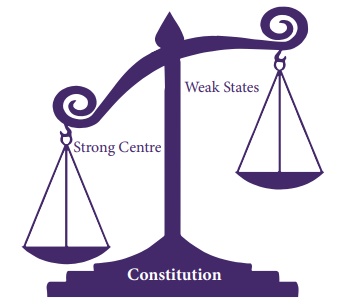Federalism in India | Political Science - Unitary or Non-Federal Features of Indian Constitution | 12th Political Science : Chapter 5 : Federalism in India
Chapter: 12th Political Science : Chapter 5 : Federalism in India
Unitary or Non-Federal Features of Indian Constitution
Unitary or Non-Federal Features of Indian Constitution
Indian Constitution differs greatly from the
concept of federalism followed in the classical federal Constitutions like the
United States
1. Single Constitution
India possesses only one Constitution that caters to
the needs of administration both in the Centre and States. Like the United
States the individual States possess their own Constitution in addition to the
national Constitution.
2. Single Citizenship
There is only one citizenship, exists in India,
i.e. national citizenship. In the United States the citizens are endowed with
both national and State citizenships.
3. Flexibility of Constitution
Indian Constitution is partially flexible. Some of
the provisions of the Constitution can be carried out by a simple majority in
the Parliament.
4. NO Right to Existence for States
Our Constitution doesn’t recognize the right of the
States to name and existence. The union parliament can change the nomenclature
and territorial identity of the States through an ordinary law. The articles 3
and 4 of the Constitution provide the procedure for the creation of new States
and abolition of the existing States. An ordinary bill is introduced in either
House of the Parliament for creating a new State or changing the name on the
recommendation of the President. The bill is discussed and passed in Parliament
leading to the creation of new States. A simple majority in Parliament is the
requirement for reshaping the identity of the States.
Activity: Do you know that Sikkim was once called an Associate State of
India?
5. Anti-Federal nature of Rajya Sabha
There are three reasons and areas where critics
have criticized it as being against the States’ rights and federal spirit of
the Constitution.
There is no equality principle followed in the
distribution of seats in the Council of States. The seats are distributed on the
basis of population of the individual States. The most populous State of Uttar
Pradesh has 31 seats whereas the smaller States like Nagaland have only one
seat. But in any ideal federalism there should be equality of seat distribution
in the upper house as seen in the United States where all the fifty State have two
seats each in the upper House of Congress (Parliament) the Senate.
Tamil Nadu has 18 Seats in the Rajya
Sabha
Article 249 of the Constitution enables the Rajya
Sabha to transfer a subject from the State List to the Union list for the
purpose of legislation by parliament on grounds of national interest.
6. Imbalanced Distribution of Powers

The Union Government is endowed with comparatively
greater powers both in terms of quantity and quality. Most of the lucrative
sources of revenue have been allotted to the Union Government and the States
have been rendered financially weaker and forever dependent on Central
Government. The Union List has more subjects than the State List and in the
Concurrent List ultimately the union power over the States will prevail. The
residuary powers are given to the Union Government and not granted to the
States as in federal countries like the United States.
7. Emergency powers
The articles 352 to 360 in Part XIII of our
Constitution provide for three kinds of emergencies in India. Article 352 of
the Constitution can proclaim National Emergency. Under article 356 of the
Constitution the President can impose emergency in any State on the grounds of
the breakdown of Constitutional machinery in the State. Under article 360 of
the Constitution, the President can declare Financial Emergency.
8. Integrated Judiciary
India establishes a single, integrated and
hierarchical judiciary. The Supreme Court is the apex judicial institution and
the High Courts and the Subordinate Courts function under its supervision and
power. In contrast, the classical federalism is following the United States.
9. Election Commission
The National Election Commission conducts elections
not only to Parliament but also to the State legislatures. There is a unified
election machinery in charge of both Parliament and State legislature
elections. The Chief Electoral Officer under the control of the Election
Commission conducts the elections to the State legislatures. In the ideal
federal systems, there is a separate election machinery for conducting
elections to the State legislature.
State Election Commission: State Election
Commission is not part of the federal system in India. It conducts elections to
Panchayat Bodies and Urban Local Bodies in accordance with 73rd and 74th
Constitutional Amendments.
10. Unified Auditing
India follows a unified auditing system for both
the central and State governments. The Comptroller and Auditor-General as
mentioned in article 148 of the Constitution controls the entire financial
system of the country.
Related Topics